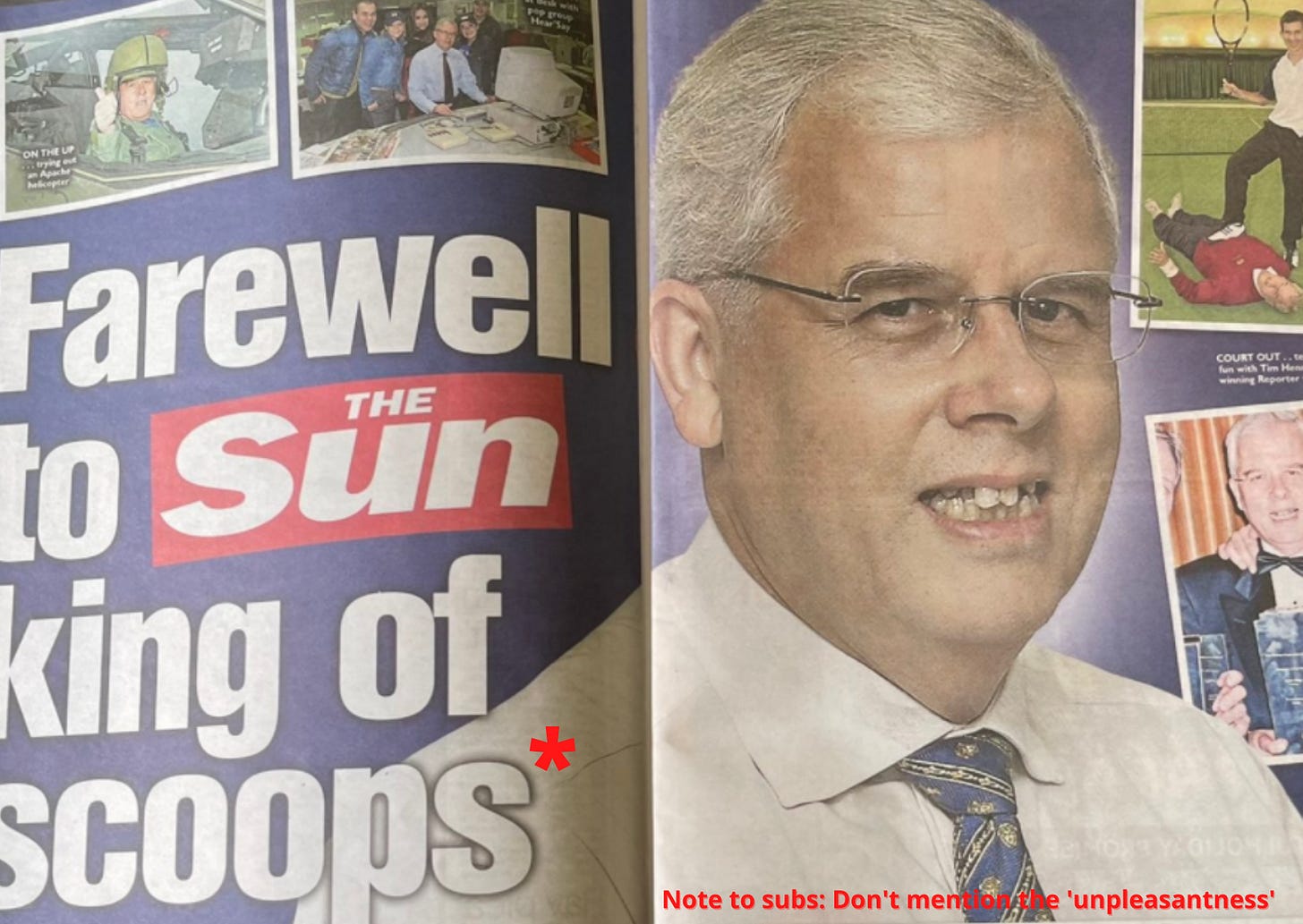The Sun’s killer obit: Fleet Street’s most hypocritical paper spins its former chief reporter’s ‘legendary’ career
John Kay killed his wife and was welcomed back into The Sun’s newsroom.
Content warning: This edition contains frank discussion of violence against women and attempted suicide. Feel free to skip this one. The Samaritans are accessible 24 hours a day on 116 123 or jo@samaritans.org
They say don’t speak ill of the dead — who are ‘they’ and why are ‘they’ so glib? — but what about being deceitful about the dead? What about flash bulbing away the shadows and darkness from someone’s life? And who is that for?
John Kay died on 7 May 2021 and The Sun, where he was latterly Chief Reporter for many years, gave him the print equivalent of a Viking funeral; a double-page spread dedicated to his obituary and an editorial singing his praises. But, as is so often the case in The Sun, there was context missing.
Because the man The Sun obit called “the greatest journalist of his generation” and “Fleet Street’s finest” killed his first wife, Harue, in 1977. But The Sun didn’t mention a word of this in its glowing tributes. No, this was a man “who inspired generation after generation of young reporters,” said Sun editor Victoria Newton.
We have no idea what Harue could have done in all those years. She didn’t get the chance. She was 27 when she died. She survives only in old newspaper reports about Kay’s crime and as a reference on his Wikipedia page. John Kay’s photograph is in the National Portrait Gallery.

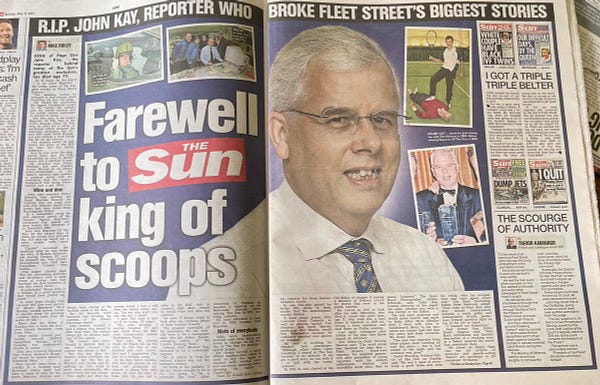
While The Sun wrote glowingly of Kay retiring “in 2015 to look after his wife Mercedes who died of cancer two years later”, Harue was erased. Her killing an unfortunate ‘blip’ in the life of an otherwise ‘good’ man.
That News International — which took Kay back after his time in a secure hospital on the proviso that he remained ‘confined to the office’ — isn’t willing to face up to what one of its stars did then isn’t surprising. Most of Fleet Street kept quiet even at the time.
The Times — not yet owned by Rupert Murdoch — referred to the case in a news in brief story on 12 September 1977, noting only that a Sun reporter was to stand trial for the murder of his wife. It was not mentioned again.
The only significant report on the trial comes from The Guardian on 13 December 1977, headlined ‘Torment’ of reporter who killed wife. It says that Kay’s QC, Daniel Hollis, one of the briefs taken on by News International told the court:
Mr Kay was cracking up at the prospect of taking over as the Sun’s industrial editor — a job he did not feel able to hold down.
Kay himself is quoted as claiming in court that he was “taken over by voices” and “seemed possessed”.
The report details how Kay killed Harue — “strangling and drowning her” — then lists Kay’s repeated attempts to take his own life — six in all — that ended with him being found covered in blood by the police after crashing his car.
Stick It Up Your Punter! The Uncut Story of the Sun Newspaper, Chris Horrie and Peter Chippindale’s unflinching look at the tabloid, provides more context on how Kay came to return to the newsroom.
Horrie and Chippindale describe Kay as…
… an ex-minor public schoolboy from St. Peter’s School York who was very keen and always seemed to be very much on top of things. But his manner was all a front… his party piece… was picking up on of the Unpopulars [the broadsheets] and effortlessly reading out its lead story in Sun-ese as he mentally rewrote it on the spot. But he was much less confident about going out ‘on the road’ to interview people.
In the aftermath of a disastrous trip to the TUC Congress in Blackpool, during which Kay locked himself in his hotel room, the authors write — drawing I assume on testimony given in court — that:
He arrived back and told his Japanese wife, Harue, whom he had married a year before, that he could not do the job. The pressure was too much for him. Neither could he resign, as that would mean his progress up the journalistic ladder would be over. He was going to kill himself, he announced. His wife was equally upset, as her family had disowned her when she married a Westerner and she would be left alone in the world.
We only have Kay’s word for this. Unlike him with his ‘miraculous’ repeated survival, Harue died that day in September 1977.
Horrie and Chippindale recount that Kay’s father blamed The Sun and its then editor Larry Lamb — later Sir Albert Lamb — agreed. The Sun hired John Matthew QC to defend Kay and Lamb sent a letter to the court saying that the newspaper would take Kay back when he was fit enough.
Kay, 33, pleaded not guilty to murder but guilty to manslaughter on the grounds of diminished responsibility. The court accepted that and he was sentenced to treatment at Friern Barnet psychiatric hospital in north London. Stick It Up Your Punter says he received regular visits from Sun colleagues and Lamb kept his promise upon Kay’s release: “The uxoricide officially became a taboo subject.”
As the years ticked up, Kay rose through the ranks at The Sun becoming its Chief Reporter in 1990. He was twice named Reporter of the Year at the British Press Awards and in 2005, Press Gazette listed him as the sixteenth most influential British reporter of the post-war age. The events of September 1977 went unmentioned.
In February 2012, Kay was back in the headlines himself. He was named as one of eight people arrested as part of Operation Elveden, an investigation into alleged illegal payments to serving police officers and civil servants.
Kay was cleared at the Old Bailey in March 2015 of paying a total of £100,000 over a decade to a member of staff at the Ministry of Defence for stories on the British Army. The Sun did pay the money to Bettina Jordan-Barber though and she was jailed for 12 months, found guilty of misconduct in public office. Kay got an ‘honourable’ discharge from The Sun, retiring in 2015.

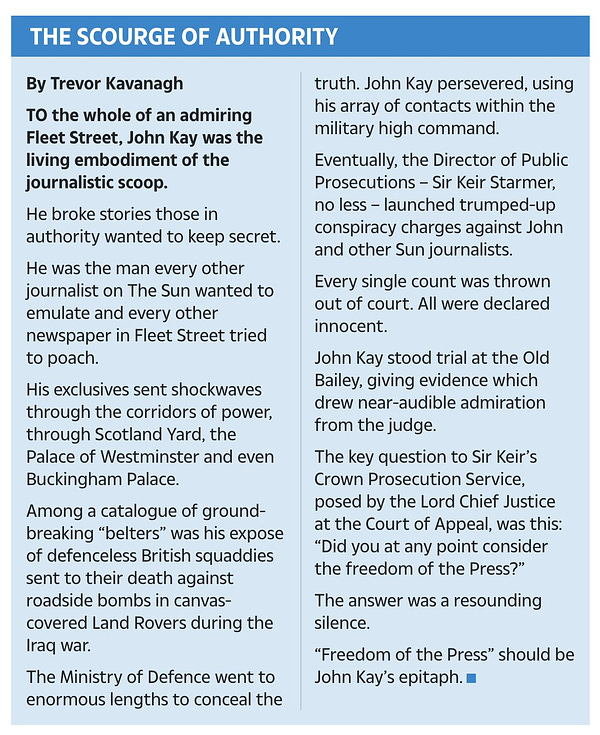
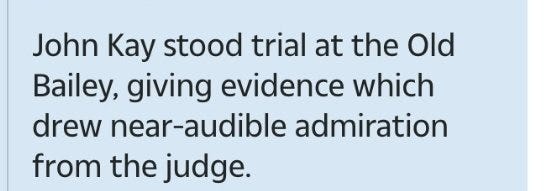
Even The Sun’s recounting of this more recent history in its tributes to Kay is distorted and partial. In a box-out headlined The scourge of authority, Trevor Kavanagh claims the case was brought on “trumped-up charges” and writes:
John Kay stood trial at the Old Bailey, giving evidence which drew near-audible admiration from the judge.
“Near-audible” seems to be a tabloid weasel wording for “non-existent”. Court and politics reporter, James Doleman, covered the case and says that Kavanagh was, in fact, “[thrown] out of court on day two for making faces at the jury and ‘clearly not being engaged in reporting’.”
No wonder that admiration was only “near audible” — Kavanagh must have been listening with a cup at the court door.
That Kavanagh’s encomium to Kay includes the line…
He was the man every other journalist on The Sun wanted to emulate.
… only increases the grim irony of the whole exercise. He ends his tribute by concluding: “‘Freedom of the Press’ should be John Kay’s epitaph.” Harue’s epitaph is not recorded in any newspaper and a better line to sum up Kay’s good fortune would be: Freedom to get away with it.
That The Sun gave Kay his job back is not the issue here. It’s a rare example of the paper showing kindness. The problem is that it has obsessed for decades over ‘killers’ who have been freed and written emotionally manipulative stories about their poor victims. It did not apply those ‘standards’ to one of its own.
In fact, in 2010, when The Sun was at the front of a tabloid pack demanding to know the new name given to Jon Venables, one of the killers of Jamie Bulger, Kay’s name was among the bylines. Louis Barfe wrote at the time:
The Sun’s coverage of the Jon Venables situation is the embodiment of all that’s worst about modern journalism… We’re looking at simple bloodlust — an eye for an eye… Meanwhile, The Sun’s coverage is being overseen by the paper’s chief reporter, John Kay. The same John Kay who, in 1977, drowned his Japanese wife Harue in the bath of their Barnet home…
… the problem for me isn’t that Kay killed his wife. I’m happy to accept that he was temporarily deranged… The problem is that The Sun showed a greater degree of enlightenment and understanding when one of its own transgressed than it would ever have done in any other circumstances. Imagine the reporting of a similar case where the killer was AN Other.
John Kay had the benefit of not being AN Other. His ability to write in tabloidese and think in the censorious yet salacious tone of The Sun gave him protection. He was protected by the paper after Harue’s killing and his protected all those years later when he claimed to not have known that paying civil servants for information was illegal.

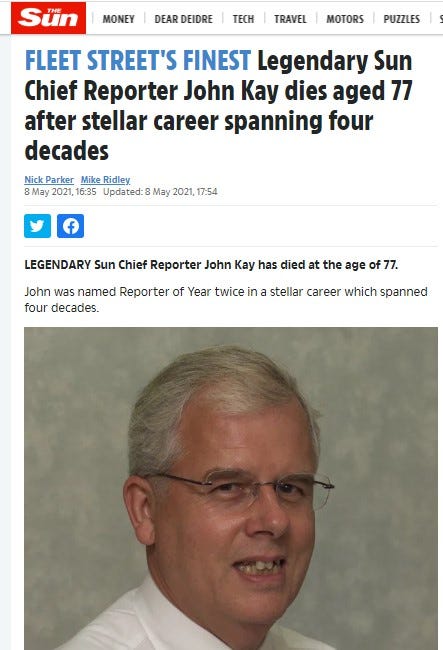
During his trial in 2015, the defence presented character witnesses. That’s par for the course, but the prosecution was prevented from mentioning Kay’s conviction for manslaughter. The judge ruled that the detail was “irrelevant” and might prejudice the jury. A reporter who covered the case told me:
We had all these senior Fleet Street figures telling us what a great guy [Kay] was and how he was always law-abiding. The prosecution was fuming.

Three years earlier, in 2012, a letter and reply to Inside Times, the prisoners newspaper, summed up the hypocrisy of The Sun’s ongoing defence of Kay.
An unnamed correspondent wrote to the paper:
The Sun ‘newspaper’ has been outraged recently over the release of one of the guys convicted of stabbing Damilola Taylor, as they usually are over the release of any convicted killer.
Imagine how ‘outraged’ Sun readers might be if they knew that the paper’s own [Chief Reporter] John Kay is a convicted killer.
John Kay was a journalist at The Sun when he was convicted of strangling and drowning his wife. He pleaded guilty due to diminished responsibility and spent just a few years in Friern Barnet mental hospital before being welcomed back to the paper. So next time someone is trying to rebuild their life after coming out of prison perhaps The Sun should remember that people in glass house shouldn’t be throwing stones.
The newspaper’s reply was short, sharp, and spot-on:
The Sun, via its reporters, has a long history of whipping up moral outrage in the public arena when it comes to prisoners and ex-prisoners. It would appear their demonising has been somewhat hypocritical.
Giving a second chance to someone with criminal convictions is an admirable action and should be reflected in their coverage of other such cases.
Remember John Kay the next time The Sun published pap pictures of a prisoner on day release or an ex-offender who has served their time. It was happy to give John Kay a job for 38 years after he committed his crime and has whitewashed his life and career now he's dead.
And if you’re a friend of his reading this and raging that I’m speaking ill of the dead, ask yourself two questions: Why didn’t The Sun speak of Harue at all? And how much ill speaking can you find in the archive of John Kay’s many stories? Like for instance the time he was tasked with making up an interview with a Falklands widow just to spoiler The Mirror?

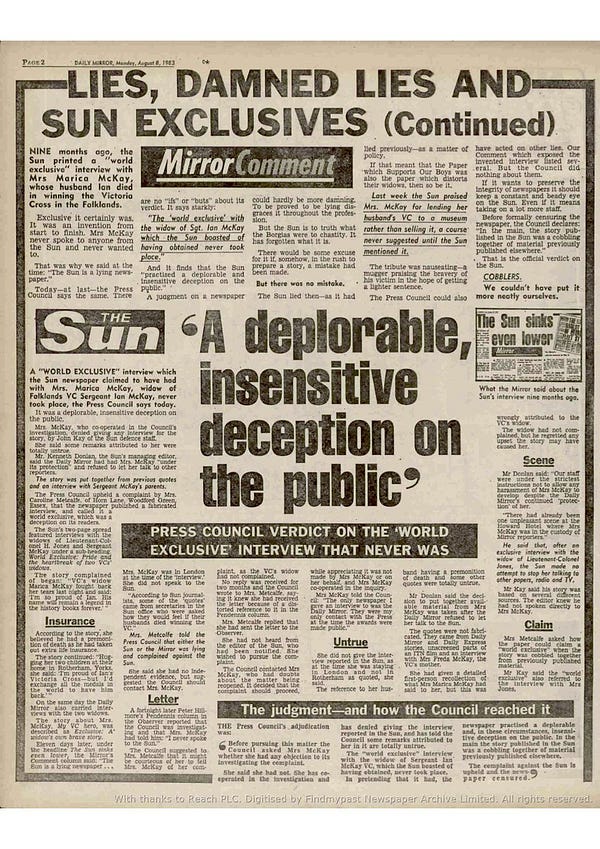
Update: The original version of this post included a quote from the contemporaneous report by The Guardian that detailed the specifics of how John Kay attempted to take his life. I have removed these after discussions with others as while they are a matter of historic record, detailing methods is advised against in Samaritans guidelines on reporting about suicide.



